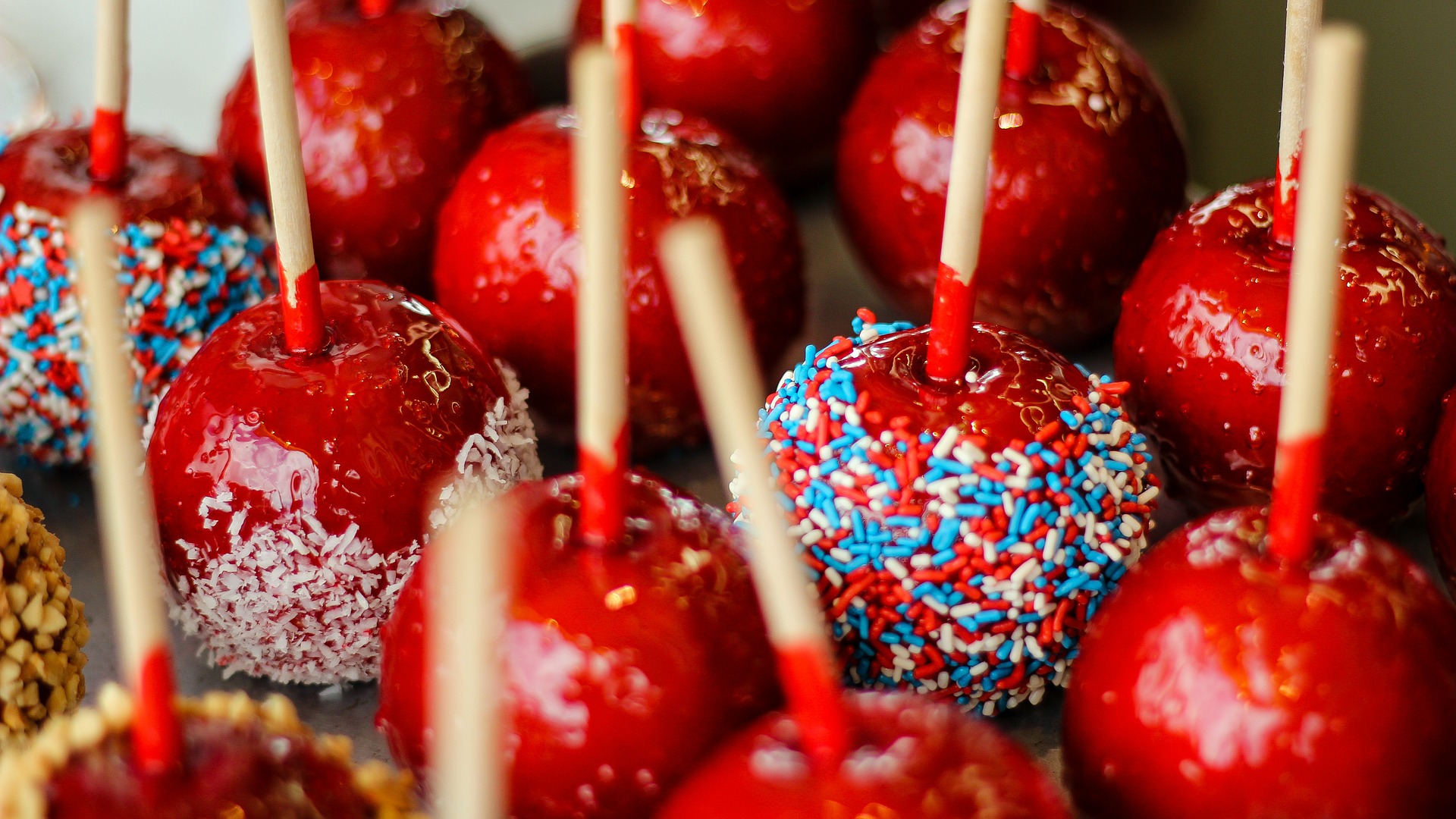In the history of candied apples we’ll of course also have to check out caramel apples.
Candied apples – also known as candy apples, toffee apples, lollipop apples, and by several other names – are apples on a stick coated with a hot candied substance, typically a combination of sugar, corn syrup, cinnamon, and red food coloring. When cooled, the candy gells or hardens around the apple.
Tart apples, such as Granny Smith, are usually recommended to use with candied apples; the tartness offsets the sweetness of the candy nicely. Also, the crispness helps to hold up the candy.
The act of coating fruit in sugar can be dated back to ancient times, when sugar was used as a preserving agent. Some form of candied apples likely dates back to the 1800s.
During the latter half of the century, toffee and caramels became more available for a lower price. FoodTimeline.org found a candied apple recipe using molasses taffy from 1919.
However, the true, traditional candied apple of today – the one with the cinnamon flavor and the vivid red color – is credited to a Newark candy maker named William Kolb.
In 1908, Kolb wished to promote a new cinnamon hard candy for the holiday season. In order to display this new treat, he dipped apples into the mixture and put the creation on display in his shop window.
The accidental candied apple turned out to be a great success. Before long, the fruit and candy combination was being sold along the New Jersey boardwalks, at fairs and festivals around the country, and finally it was being enjoyed around the world.
In addition to creating a lasting treat, Kolb is responsible for the candied apple color craze – now the color is used on cars, guitars, and many other things.
Interestingly, other countries have differing traditions surrounding the candied fruit on a stick than we do. We Americans primarily associate candied apples with Halloween, but not everyone eats them at that time.
Here is a small breakdown of when other countries enjoy candied apples:
- South America: Christmastime
- Germany: Christmastime
- Canada: At fairs
- Japan: At festivals
- Israel: Yom Ha’atzmaut Eve (their Independence Day)
- UK: Guy Fawkes Night (also known as Bonfire Night) (November 5th)
Ireland and Scotland enjoy them when we do – Halloween.
China has a similar dessert to candied apples called Tanghulu, which consists of coating many small fruits in candy.
Finally, we have caramel apples, which are a variation of candied apples to some degree – we’ll expand upon the differences momentarily. Today, caramel apples are definitely more popular in America than the classic candied red apples.
A Kraft employee by the name of Dan Walker created caramel apples in the 1950s. He did so to expand upon the company’s line of individually wrapped caramels. Initially, they were all created by hand, a tedious process. Until, Vito Raimondi invented the first caramel apple machine.
Candied apples are formed by submerging the apple in a sugar coating, which is then heated to “hard crack stage.” This is the hottest stage for heating candy, compared to softball stage and soft crack stage.
The higher the temperature is, the harder the candy will be. Once candied apples have reached the hard crack level, they can be cooled.
Comparatively, caramel apples have a much gooier, stickier coating, of course made from melted caramels. Candied apples are significantly harder than caramel apples. Caramel apples you can just bite right into, but candied you have to be a bit more careful, not unlike with a jawbreaker.
Although caramel apples are all the rage right now, surprise your guests this Halloween with something different: old fashioned candied apples.

I have not been able to find this wonderful great cinn.
this is great.